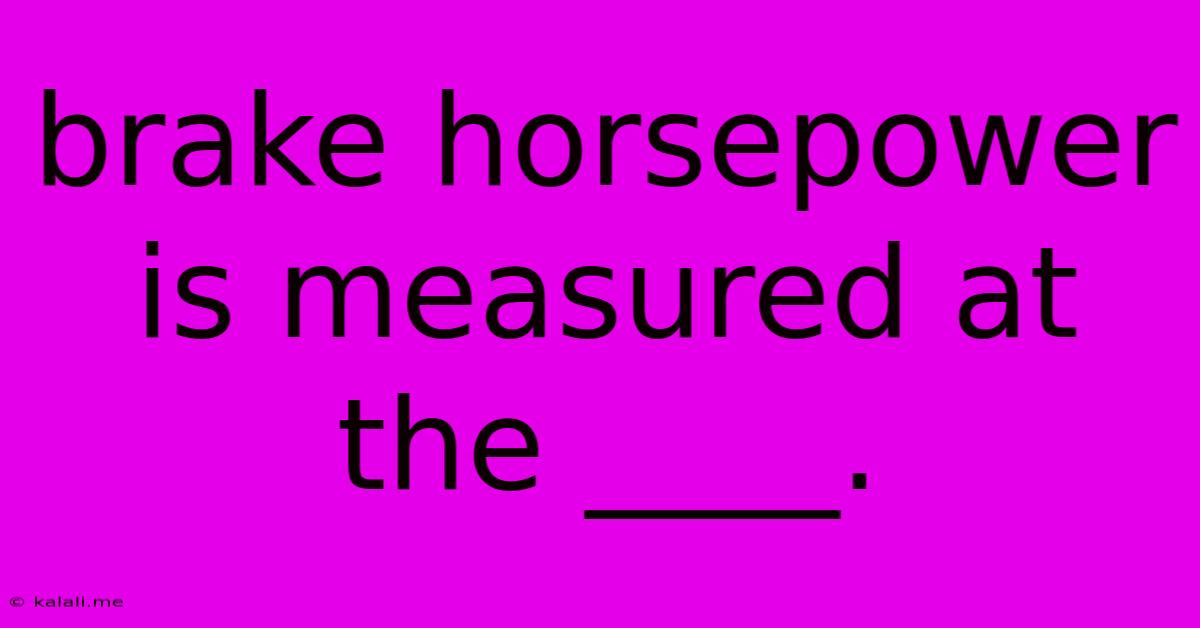Brake Horsepower Is Measured At The ____.
Kalali
Jun 12, 2025 · 3 min read

Table of Contents
Brake Horsepower is Measured at the Crankshaft
Brake horsepower (bhp) is a crucial measure of an engine's power output. Understanding where and how it's measured is key to interpreting engine specifications and performance. This article will clarify that brake horsepower is measured at the crankshaft. We'll delve into the why and how, exploring the process and contrasting it with other power measurements.
Understanding Brake Horsepower
Before diving into the location of measurement, let's briefly define brake horsepower. It represents the actual mechanical power produced by an engine's crankshaft, before any power losses due to transmission, drivetrain friction, or other auxiliary components. This makes it a more accurate reflection of the engine's raw power compared to other metrics like wheel horsepower (whp).
The term "brake" in brake horsepower refers to the dynamometer's braking mechanism used during the measurement process. A dynamometer is a device that applies a load to the engine, simulating real-world driving conditions. This load is what allows for the accurate measurement of the engine's power output.
Why the Crankshaft?
The crankshaft is the heart of the engine's power delivery system. It converts the reciprocating motion of the pistons into rotational motion, which is then transmitted through the drivetrain to ultimately power the wheels. Measuring bhp at the crankshaft captures the total power generated by the engine before any energy is lost.
Measuring at this point eliminates the variables introduced by the transmission, differential, axles, and tires. These components all contribute to frictional losses, reducing the power available at the wheels. Therefore, bhp provides a standardized, engine-specific measure of power unaffected by drivetrain efficiency.
The Measurement Process
The measurement process involves connecting the engine's crankshaft to a dynamometer. The dynamometer applies a controlled resistance, allowing the engine to operate under a load. Sensors within the dynamometer precisely measure the engine's torque and speed (RPM). These values are then used to calculate the bhp using the following formula:
Bhp = (Torque x RPM) / 5252
Where:
- Torque is measured in pound-feet (lb-ft) or Newton-meters (Nm).
- RPM represents the engine's rotational speed in revolutions per minute.
- 5252 is a constant derived from the units of measurement.
This formula ensures a consistent and accurate measurement of the engine's brake horsepower. Different types of dynamometers exist, each employing different braking mechanisms, but the fundamental principle remains the same: measuring the engine's output at the crankshaft.
Brake Horsepower vs. Wheel Horsepower
It's crucial to distinguish between brake horsepower and wheel horsepower (whp). While bhp measures power at the crankshaft, whp measures the power delivered to the wheels. Because of drivetrain losses, whp is always lower than bhp. The difference between these two values represents the power lost due to friction in the transmission, axles, and other drivetrain components. This difference can vary significantly depending on the vehicle's drivetrain design and condition.
Conclusion
In summary, brake horsepower is measured at the crankshaft, providing a standardized and reliable measure of an engine's raw power. Understanding this fundamental aspect of engine performance is crucial for anyone interested in automotive engineering, vehicle performance, or simply comparing different engines. By measuring at the crankshaft, we get a pure representation of the engine's capabilities, independent of drivetrain efficiency.
Latest Posts
Latest Posts
-
Which Of The Following Sequences Is Correct
Jun 13, 2025
-
What Is This Passage Mainly About
Jun 13, 2025
-
Which Of The Following Is Not An Example Of Matter
Jun 13, 2025
-
Whats The Difference Between Registered Mail And Certified Mail
Jun 13, 2025
-
How Many Square Meters Are In A Square Mile
Jun 13, 2025
Related Post
Thank you for visiting our website which covers about Brake Horsepower Is Measured At The ____. . We hope the information provided has been useful to you. Feel free to contact us if you have any questions or need further assistance. See you next time and don't miss to bookmark.